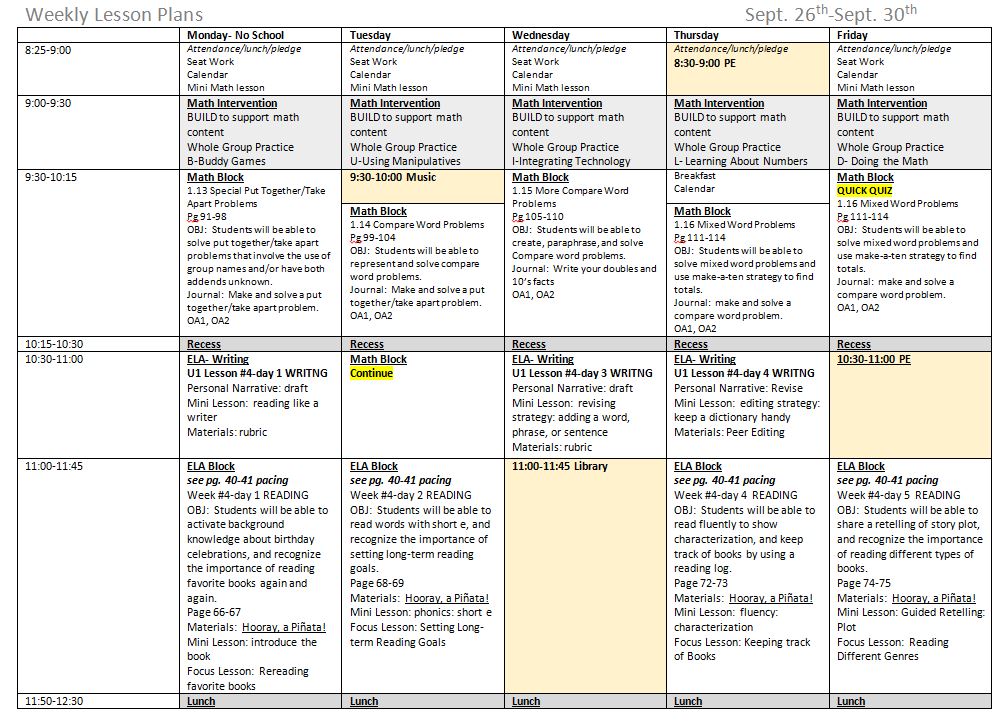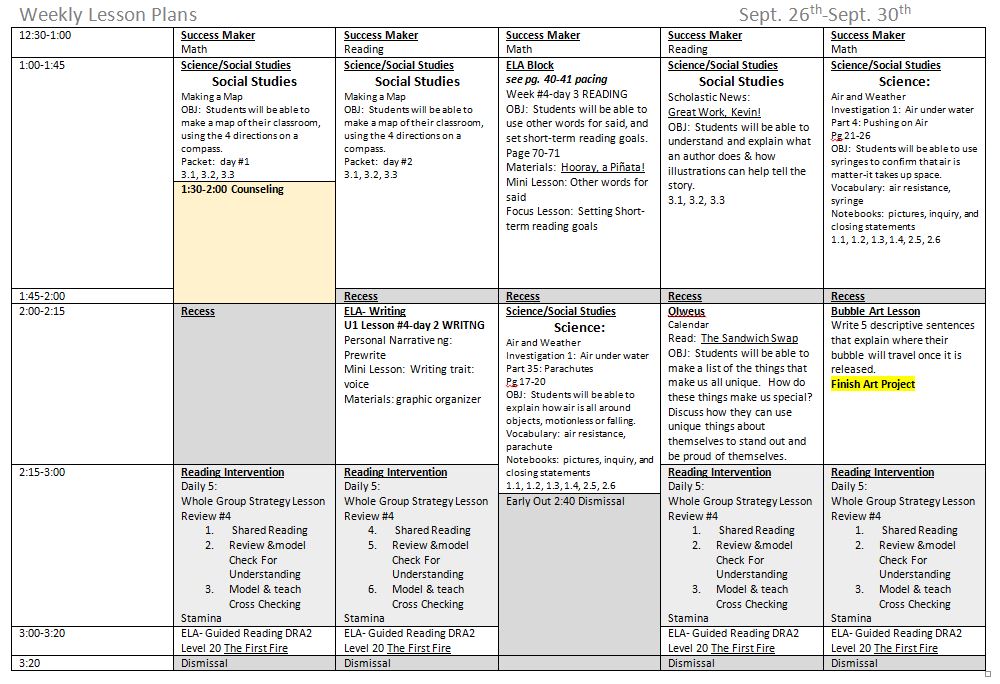5 Components to a Great Weekly Lesson Plan
10/7/2016

What are the five most important components that should be in every lesson plan? Can you make your list with just five components? I think it can be done, even though Madeline Hunter may tell you there are more. In fact, a Madeline Hunter lesson plan includes these seven components¹:
Materials/Resources Needed:
- Anticipatory Set (In what way will you activate their prior knowledge and experience to help them relate to today's lesson.) Focus attention, brief practice on previous/related learning
- Objective/Purpose (The object is what students will be able to know/do by the end of this lesson. The overarching purpose/understanding is the broad goal/curriculum standard related to the discipline.)
- Instructional Input (What knowledge will you communicate to the student--tell, lecture, stand up and deliver so that the student will understand the objective.) Disseminates new information and activities to achieve the stated objectives
- Modeling (How will you show/demonstrate the skill or competence so the student will also be able to do it?) Demonstration and/or example of the acceptable finished product or process
- Checking for Understanding (How will you check that the students have understood/learned the objectives?) Activities which examine the student's possession of central and essential information to achieve the stated objective
- Guided Practice (What activities will the students perform under your supervision to ensure that they are able to practice the material. If they make mistakes, you are able to show them how to do it correctly.) Close monitoring and direction of the students by the instructor as they practice the whole task for the first time independently of each other
- Independent Practice (List homework or seatwork assignments the students will be given to successfully practice the material/skill without teacher supervision.) Only after you know the students can proceed, the continued practice of the whole task by the students without the instructor's monitoring and guidance.
I believe you can tell the story (because that's what a lesson plan is ultimately) of student achievement with five main components. When you look at the lesson plan below you may say, "Well, the teacher can still do all those Madeline Hunter components in each lesson." I agree, but how much should a teacher have to communicate? A teacher would be spending an exorbitant amount of hours if they were required to do a Madilyn Hunter lesson plan for every lesson. These five components tell you a lot about the teacher and the student.
We know that over the half the battle of teaching is being ready. Master teachers spend time examining where their students are academically, even socially, and then determine where the students are going for the upcoming week. When planning, master teachers take into account so many different factors: school events, support from other teachers, how fast the class moves through the curriculum standards, reviewing other data that determines how fast or slow the teacher can introduce new topics, as well as connecting to older topics. The planning a teacher does is evident in their weekly plans, and even more evident when you watch them during instruction. These teachers don't just plan to meet district, school, or even the principal's expectations, they develop plans to meet the needs of the kids first!
We have come a long way from Madeline Hunter's 7-step lesson plan format from above. Though Madilyn's plan does allow for some flexibility, master teachers know they have to be even more flexible as a couple students, or even one student, can change the course of your weekly instructional vision. In our elementary school we have five main components that tell that teacher/student story:
- State Standards Addressed
- Lesson Objective
- Materials Needed for Lesson
- Assessment
- Structure
1- State Standards
85% of our curriculum is based on the Common Core Standards and another 15% is built from local standards. In Montana, Indian Education for All curriculum standards comprises the other 15%. The standards have been aptly renamed, Montana's Common Core Standards.
Routinely I state my philosophy and mantra with teachers, "We are responsible to these standards, and not to a text book." Yes, we spend time reviewing text books and subsequently purchasing them all in the hopes that they meet as many standards as possible. I have yet to find a text book that meets all the standards. This is where teachers have to be that consummate professional and find materials to supplement. Many school boards require specific curriculum which, in turn, makes it a directive to use the board adopted curriculum. We cannot just grab any materials we like. Ultimately, we are responsible to the students and their families in making sure they meet the state standards.
Tracking these standards on lesson plans helps teachers understand and assess how their students are doing towards their mastery. On our lesson plans we also know how many times we have addressed these standards. We can then target specific standards according to data; this can be done for the class and for individual students. This can be powerful!
2 - Lesson Objective
By stating what the student will be able to after the lesson gives us a goal and target for each student. We can then assess our instructional effectiveness and student mastery of the standards. The objective is tied directly to the standard being taught. By including the objective we can focus our learning for given segment of time, as well as checking for understanding all throughout the lesson. Creating a great objective in a lesson plan may come from the textbook/materials or it can be created by the teacher.
3 - Selecting the Right Materials
Once you know the standard you want to address, and have created your lesson objective, you can now find the materials needed to instruct the students that are in your classroom. As mentioned above, our teachers will use all the information they have on their students to determine the best way to teach the objective to mastery. They will start with the board adopted curriculum and may supplement with other materials as needed (this may be controversial or possibly not even allowed in some districts due to the board adopted curriculum and fidelity to ONE program ONLY). Make sure you know your principal's philosophy and the expectations of your school district.
4 - Assessment
The assessment of every objective is imperative. This can be done in a summative assessment or quick formative assessment. Assessment data gives the teacher needed information on instructional effectiveness (as determined by data), how well the students did on the objective (whole class and individually), and gives the teacher great information on where to go next with instruction.
5 - Structure
A master teacher needs to know how all these lessons fit together in a weekly plan (or weekly story). Certain routines and events happen every day. Then there are things that cannot be planned for and flexibility is a necessity! Time provides this structure: deciding what's best for students in the time given is truly an art form.
Take a look at a sample weekly plan. It is easy to follow - see below pics. One could pay oodles of money to put all this information into a Web 2.0 lesson plan template. You can save money by believing in these five components listed above and putting it into an Excel spreadsheet to tell the story. Using this process, a master teacher is not letting a page number on a specific day dictate their lesson planning. We know these teachers are going to make gains with all students academically and socially!
Footnote:
Madeline Hunter's Lesson Plan Format. (n.d.). Retrieved October 2, 2016, from http://template.aea267.iowapages.org/lessonplan/ (PDF)


- Learning How to Say No and Set Boundaries with Parents - November 21, 2022
- If You Had Only One Behavior Strategy to Use in Your Classroom, What Would It Be? - September 26, 2022
- Live Your Code: 7 Strategies That Will Help You Be the Most Effective Educator You Can Be - August 15, 2022












